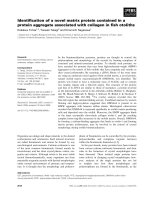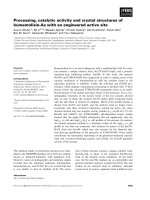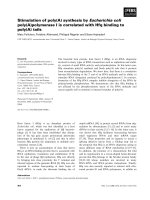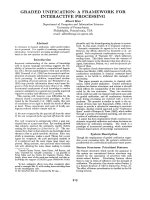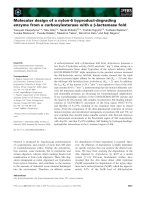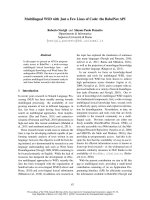Báo cáo khoa học: "PROCESSING ENGLISH WITH A GENERALIZED PHRASE STRUCTURE GRAMMAR" pdf
Bạn đang xem bản rút gọn của tài liệu. Xem và tải ngay bản đầy đủ của tài liệu tại đây (750.52 KB, 8 trang )
PROCESSING ENGLISH WITH A
GENERALIZED PHRASE STRUCTURE GRAMMAR
Jean Mark Gawron, Jonathan King, John Lamping, Egon Loebner,
Eo Anne Paulson, Geoffrey K. Pullum, Ivan A. Sag, and Thomas Wasow
Computer Research Center
Hewlett Packard Company
1501 Page Mill Road
Palo Alto, CA 94304
ABSTRACT
This paper describes a natural language
processing system implemented at Hewlett-Packard's
Computer Research Center. The system's main
components are: a Generalized Phrase Structure
Grammar (GPSG); a top-down parser; a logic
transducer that outputs a first-order logical
representation; and a "disambiguator" that uses
sortal information to convert "normal-form"
first-order logical expressions into the query
language for HIRE, a relational database hosted in
the SPHERE system. We argue that theoretical
developments in GPSG syntax and in Montague
semantics have specific advantages to bring to this
domain of computational linguistics. The syntax
and semantics of the system are totally
domain-independent, and thus, in principle,
highly portable. We discuss the prospects for
extending domain-independence to the lexical
semantics as well, and thus to the logical semantic
representations.
I. INTRODUCTION
This paper is an interim progress report on
linguistic research carried out at Hewlett-Packard
Laboratories since the summer of 1981. The
research had three goals: (1) demonstrating the
computational tractability of Generalized Phrase
Structure Grammar (GPSG), (2) implementing a
GPSG system covering a large fragment of English,
and (3) establishing the feasibility of using GPSG
for interactions with an inferencing knowledge
base.
Section 2 describes the general architecture
of the system. Section 3 discusses the grammar
and the lexicon. A brief dicussion of the parsing
technique used in found in Section 4. Section 5
discusses the semantics of the system, and Section
6 presents ~ detailed example of a parse-tree
complete with semantics. Some typical examples
that the system can handle are given in the
Appendix.
The system is based on recent developments
in syntax and semantics, reflecting a modular view
in which grammatical structure an~ abstract logical
structure have independent status. The
understanding of a sentence occurs in a number of
stages, distinct from each other and governed by
different principles of organization. We are
opposed to the idea that language understanding
can be achieved without detailed syntactic
analysis. There is, of course, a massive
pragmatic component to human linguistic
interaction. But we hold that pragmatic inference
makes use of a logically prior grammatical and
semantic analysis. This can be fruitfully modeled
and exploited even in the complete absence of any
modeling of pragmatic inferencing capability.
However, this does not entail an incompatibility
between our work and research on modeling
discourse organization and conversational
interaction directly= Ultimately, a successful
language understanding system wilt require both
kinds of research, combining the advantages of
precise, grammar-driven analysis of utterance
structure and pragmatic inferencing based on
discourse structures and knowledge of the world.
We stress, however, that our concerns at this
stage do not extend beyond the specification of a
system that can efficiently extract literal meaning
from isolated sentences of arbitrarily complex
grammatical structure. Future systems will exploit
the literal meaning thus extracted in more
ambitious applications that involve pragmatic
reasoning and discourse manipulation.
The system embodies two features that
simultaneously promote extensibility, facilitate
modification, and increase efficiency. The first is
that its grammar is context-free in the informal
sense sometimes (rather misleadingly) used in
discussions of the autonomy of grammar and
pragmatics: the syntactic rules and the semantic
translation rules are independent of the specific
application domain. Our rules are not devised ad
hoc with a particular application or type of
interaction in mind. Instead, they are motivated
by recent theoretical developments in natural
language syntax, and evaluated by the usual
linguistic canons of simplicity and generality. No
changes in the knowledge base or other exigencies
deriving from a particular context of application
can introduce a problem for the grammar (as
distinct, of course, from the lexicon).
The second relevant feature is that the
grammar ir the- system is context-free in the sense
of formal language theory. This makes the
extensive mathematical literature on context-free
phrase structure grammars (CF-PSG's) directly
relevant to the enterprise, and permits utilization
of all the well-known techniques for the
computational implementation of context-free
grammars. It might seem anachronistic to base a
language understanding system on context-free
74
parsing. As Pratt (1975, 423) observes: "It is
fashionable these days to want to avoid all
reference to context-free grammars beyond warning
students that they are unfit for computer
consumption as far as computational linguistics is
concerned." Moreover, widely accepted arguments
have been given in the linguistics literature to the
effect that some human languages are not even
weakly context-free and thus cannot possibly be
described by a CF-PSG. However, Gazdar and
Pullum (1982) answer all of these arguments,
showing that they are either formally invalid or
empirically unsupported or both. It seems
appropriate,
therefore, to take a renewed interest
in the possibility of CF-PSG description of human
languages, both in computational linguistics and in
linguistic research generally.
2. COMPONENTS OF THE SYSTEM
The linguistic basis of the GPSG linguistic
system resides in the work reported in Gazdar
(1981, 1982) and Gazdar, Pullum, and Sag (1981). 1
These papers argue on empirical and theoretical
grounds that context-freeness is a desirable
constraint on grammars. It clearly would not be
so desirable, however, if (1) it led to lost
generalizations or (2) it resulted in an
unmanageable number of rules in the grammar.
Gazdar (1982) proposes a way of simultaneously
avoiding these two problems. Linguistic
generalizations
can be captured in a context-free
grammar with a
metagrammor,
i.e. a higher-level
grammar that generates the actual grammar as its
language. The
metagrammar
has two kinds of
statements:
(1) Rule schemata. These are
basically like ordinary rules, except that
they contain variables ranging over
categories and features.
(2) Metarules. These are implicational
statements, written in the form ===>B,
which capture relations between rules. A
metarule ===>t~ is interpreted as saying,
"for every rule that is an instantiation of
the schema =, there is a corresponding rule
of form [5." Here 13 will be @(~), where 8
issome mapping specified partly by the
general theory of grammar and partly in
the metarule formulation. For instance,
it is taken to be part of the theory of
grammar that @ preserves unchanged the
subcategorization (rule name) features of
rules (cf. below).
The GPSG system also assumes the
Rule-to-Rule Hypothesis, first advanced by
Richard Montague, which requires that each
syntactic rule be associated with a single semantic
I.
See also Gazdar, Pullum, Sag, and Wasow
(1982) for some further discussion and comparison
with other work in the linguistic literature.
translation rule. The syntax-semantics match is
realized as follows: each rule is a triple consisting
of a rule name, a syntactic statement (~ormally a
local condition on node admissibility), and a
semantic translation, specifying how the
higher-order logic representations of the daughter
nodes combine to yield the correct translation for
the mother. =
The present GPSG system has five
components :
1. Grammar
a. Lexicon
b. Rules and Metarules
2. Parser and Grammar Compiler
3. Semantics Handler
4. Disambiguator
5. HIRE database
3. GRAMMAR AND LEXICON
The grammar that has been implemented thus
far is only a subset of a much larger GPSG
grammar that we have defined on paper. It
nevertheless describes a broad sampling of the
basic constructions of English, including a variety
of prepositional phrase constructions, noun-noun
compounds, the auxiliary system, genitives,
questions and relative clauses, passives, and
existential sentences.
Each entry in the lexicon contains two kinds
of information about a lexical item, syntactic and
semantic. The syntactic part of an entry consists
of a syntactic feature specification; this includes,
inter alia,
information about any irregular
morphology the item may have, and what is known
in
the linguistic literature as
strict
subcategorization
information. In our terms the
latter is information linking lexical items of a
particular category to specific environments in
which that category is introduced by phrase
structure rules. Presence in the lexical entry for
an item I of the feature R (where R is the name
of a rule) indicates that / may appear in
structures admitted by
R,
and absence indicates
that it may not.
The semantic information in a lexical entry is
sometimes simple, directly linking a lexical item
with some HIRE predicate or relation. With verbs
or prepositions, there is also a specification of
what case roles to associate with particular
arguments (cf. below for discussion of
case
roles).
Expressions that make a complex logical
contribution to the sentence in which they appear
witl in general have complicated translations.
Thus
every
has the translation-
2. There is a theoretical issue here about
whether semantic translation rules need to be
stipulated for each syntactic rule or whether there
is a general way of predicting their form. See
Klein and Sag (t981) for an attempt to develop the
latter view, which is not at present implemented
in our system.
75
(LAMBDA P (LAMBDA Q ((FORALL X (P X))
> (Q x)))),
This indicates that it denotes a function which
takes as argument a set P, and returns the set of
properties that are true of all members of that set
(cf. below for slightly more detailed discussion).
A typical rule looks like this:
<VPI09: V] -> V N]! N!I2: ((V N!!2) N!!)>
The exclamation marks here are our notation for
the bars in an X-bar category system. (See
Jackendoff (1977) for a theory of this
type though one which differs on points of detail
from ours.) The rule has the form <a: b: c>.
Here a is the name 'VP109'; b is a condition that
will admit a node labeled 'V!' if it has three
daughter nodes labeled respectively 'V' (verb),
'Nit' (noun phrase at the second bar level), and
'NI!' (the numeral 2 being merely an index to
permit reference to a specific symbol in the
semantics, the metarules, and the rule compiler,
and is not a part of the category label); and c is
a semantic translation rule stating that the V
constituent translates as a function expression
taking as its argument the translation of the
second N!!, the result being a function expression
to be applied to the translation of the first N!!.
By a general convention in the theory of
grammar, the rule name is one of the feature
values marked on the lexical head of any rule that
introduces a lexical category (as this one
introduces V). Only verbs marked with that
feature value satisfy this rule. For example, if we
include in the lexicon the word give and assign to
it the feature VPI09, then this rule would generate
the verb phrase gave Anne a job.
A typical metarule is the passive metarule,
which looks like this (ignoring semantics):
<PAS: <V! -> V NI! W > => <V! -> V[PAS] W>>
W is a string variable ranging over zero or more
category symbols. The metarule has the form <N:
<A> => <B>>, where N is a name and <A> and <B >
are schemata that have rules as their instantiations
when appropriate substitutions are made for the
free variables. This metarule says that for every
rule that expands a verb phrase as verb followed
by noun phrase followed by anything else
(including nothing else), there is another rule that
expands verb phrase as verb with passive
morphology followed by whatever followed the noun
phrase in the given rule. The metarule PAS would
apply to grammar rule VP109 given above, yielding
the
rule:
<VP109: V! -> V[PAS] N{!>
As we noted above, the rule number feature is
preserved here, so we get Anne was given a job,
where the passive verb phrase is given a job,
but not *Anne was hired a job. 3
Passive sentences are thus analyzed directly,
and not reduced to the form of active sentences in
the course of being analyzed, in the way that is
familiar from work on transformational grammars
and on ATN's. However, this does not mean that
no relation between passives and their active
counterparts is expressed in the system, because
the rules for analyzing passives are in a sense
derivatively defined on the basis of' rules for
analyzing actives.
More difficult than treating passives and the
like, and often cited as literally impossible within a
context-free grammar'," is treating constructions
like questions and relative clauses. The apparent
difficulty resides in the fact that in a question like
Which employee has Personnel reported that Anne
thinks has performed outstandingly?, the portion
beginning with the third word must constitute a
string analyzable as a sentence except that at some
point it must lack a third person singular noun
phrase in a position where such a noun phrase
could otherwise have occurred. If it lacks no
noun phrase, we get ungrammatical strings of the
type *Which employee has Personnel reported that
Anne thinks Montague has performed
outstandingly?. If it lacks a noun phrase at a
position where the verb agreement indicates
something other than a singular one is required,
we get ungrammaticalities like *Which employee has
Personnel reported that Anne thinks have
performed outstandingly?. The problem is thus
one of guaranteeing a grammatical dependency
across a context that may be arbitrarily wide,
while keeping the grammar context-free. The
technique used is introduced into the linguistic
literature by Gazdar (1981). It involves an
augmentation of the nonterminal vocabulary of the
grammar that permits constituents with "gaps" to
be treated as not belonging to the same category
as similar constituents without gaps. This would
be an unwelcome and inelegant enlargement of the
grammar if it had to be done by means of
case-by-case stipulation, but again the use of a
metagrammar avoids this. Gazdar (1981) proposes
a new set of syntactic categories of the form a/B,
where ~ and 15 are categories from the basic
nonterminal vocabulary of the grammar. These are
called slash categories. A slash category e/B may
be thought of as representing a constituent of
category = with a missing internal occurrence of !5.
We employ a method of introducing slash categories
that was suggested by Sag (1982): a metarule
stating that for every rule introducing some B
under = there is a parallel rule introducing 15/~
under =/~. In other words, any constituent can
have a gap of type ~" if one of its daughter
constituents does too. Wherever this would lead to
a daughter constituent with the label [/~' in some
3. ~ regard was given a job not as a passive
verb phrase itself but as a verb phrase containing
the verb be plus a passive verb phrase containing
given and a job.
4. See Pullum and Gazdar (1982) for references.
76
rule, another metarule allows a parallel rule
without the ~'/;r, and therefore defines rules that
allow for actual
gaps i.e.,
missing constituents.
In this
way,
complete sets of rules for describing
the unbounded dependencies found in interrogative
and relative clauses can readily be written. Even
long-distance agreement facts can be (and are)
captured, since the morphosyntactic features
relevant to a specific
case
of agreement are
present in the feature composition of any given ~'.
4. PARSING
The system is initialized by expanding out
the grammar. That is, tile metarules are applied
to the rules to produce the full rule set, which is
then compiled and used by the parser. Metarules
are not consulted during the process of parsing.
One might well wonder about the possible benefits
of the other alternative: a parser that made the
metarule-derived rules to order each time they
were needed, instead of consulting a precompiled
list. This possibility has been explored by Kay
(1982). Kay draws an analogy between metarules
and phonological rules, modeling both by means of
finite state transducers. We believe that this line
is worth pursuing; however, the GPSG system
currently operates off a precompiled set of rules.
Application of ten metarules to forty basic
rules yielded 283 grammar rules in the 1/1/82
version of the GPSG system. Since then the
grammar has been expanded somewhat, though the
current version is still undergoing some
debugging, and the number of rules is unstable.
The size of the grammar-plus-metarules system
grows by a factor of five or six through the rule
compilation. The great practical advantage of
using a metarule-induced grammar is, therefore,
that the work of designing and revising the system
of linguistic rules can proceed on a body of
statements that is under twenty percent of the size
it would be if it were formulated as a simple list of
context-free rules.
The system uses a standard type of
top-down parser with no Iookahead, augmented
slightly to prevent it from looking for a given
constituent starting in a given spot more than
once. It produces, in parallel, all legal parse
trees for a sentence, with semantic translations
associated with each node.
5. SEMANTICS
The semantics handler uses the translation
rule associated with a node to construct its
semantics from the semantics of its daughters.
This construction makes crucial use of a procedure
that we call Cooper storage (after Robin Cooper;
see below). In the spirit of current research in
formal semantics, each syntactic constituent is
associated directly with a single logic expression
(modulo Cooper Storage), rather than any program
or procedure for producing such an expression.
Our semantic analysis thus embraces the principle
of "surface compositionality." The semantic
representations derived at each node are referred
to as the Logical Representation (LR).
The disambiguator provides the crucial
transition from LR to HIRoE queries; the
disambiguator uses information about the
sort,
or
domoin of definition,
of various terms in the logical
representation. One of the most important
functions of the disambiguator is to eliminate
parses that do not make sense in the conceptual
scheme of HIRE.
HIRE is a relational database with a certain
amount of inferencin9 capability. It is implemented
in SPHERE, a database system which is a
descendant of FOL (described in Weyhrauch
(1980)). Many of the relation-names output by
the disambiguator are derived relations defined by
axioms in SPHERE. The SPHERE environment was
important for this application, since it was
essential to have something that could process
first-order logical output, and SPHERE does just
that. A noticeable recent trend in database theory
has been a move toward an interdisciplinary
comingling of mathematical logic and relational
database technology (see especially Gallaire and
Minker (1978) and
Gallaire,
Minker and Nicolas
(198])). We regard it as an important fact about
the GPSG system that links computational
linguistics to first-order logical representation
just as the work referred to above has linked
first-order logic to relational database theory. We
believe that SPHERE offers promising prospects for
a knowledge representation system that is
principled and general in the way that we have
tried to exemplify in our syntactic and semantic
rule system. Filman, Lamping and Montalvo (]982)
present details of some capabilities of SPHERE that
we have not as yet exploited in our work,
involving the use of multiple contexts to represent
viewpoints, beliefs, and modalities, which are
generally regarded as insuperable stumbling-blocks
to first-order logic approaches.
Thus far the linguistic work we have
described has been in keeping with GPSG
presented in the papers cited above. However two
semantic innovations have been introduced to
facilitate the disambiguator's translation from LR to
a HIRE query. As a result the linguistic system
version of LR has two new properties:
(1) The intensional logic of the published
work was set aside and LR was designed to be an
extensional first-order language. Although
constituent translations built up on the way to a
root node may be second-order, the system-
maintains first-order reducibility. This
reducibility is illustrated by the following analysis
of noun phrases as second-order properties
(essentially the analysis of Montague (]970)). For
example, the proper name
Egon
and the quantified
noun phrase
every opplicant
are both translated as
sets of properties:
77
Egon = LAMBDA P (P EGON)
Every applicant = LAMBDA P (FORALL X
((APPLICANT X) > (P X)))
Egon is translated as the set of properties
true of Egon, and every applicant, as the set of
properties true of all applicants. Since basic
predicates in the logic are first-order, neither of
the
above expressions can be made the direct
• argument of any basic predicate; instead the
argument is some unique entity-level variable
which is later bound to the quantifier-expression
by quantifying in. This technique is essentially
the
storage device proposed in Cooper (1975).
One
advantage of this method of "deferring" the
introduction into the interpretation process of
phrases with quantifier meanings is that it allows
for a natural, nonsyntactic treatment of scope
ambiguities. Another is that with a logic limited to
first-order predicates, there is still a natural
treatment for coordinated noun phrases of
apparently heterogeneous semantics, such as Egon
and every applicant.
(2) HIRE represents events as objects. All
objects in the knowledge base, including events,
belong to various sorts. For our purposes, a sort
is a set. HIRE relations are declared as properties
of entities within particular sorts. For example,
there is an employment sort, consisting of various
particular employment events, and an
employment.employee relation as well as
employment .organization and employment.manager
relations. More conventional relations, like
employee.manager are defined as joins of the basic
event
relations. This allows the semantics to make
some fairly obvious connections between verbs and
events (between, say, the verb work and events
of employment), and to represent different
relations between a verb and its arguments as
different first-order relations between an event
and its participants. Although the lexical
treatment sketched here is clearly domain
dependent (the English verb work doesn't
necessarily involve employment events), it was
chosen primarily to simplify the ontology of a first
implementation. As an alternative, one might
consider associating work with events of a sort
labor, one of whose subsorts was an employment
event, defining employments as those labors
associated with an organization.
Whichever choice one makes about the basic
event-types of verbs, the mapping from verbs to
HIRE relations cannot be direct. Consider a
sentence like Anne work5 for Egon. The HIRE
representation will predicate the
employment.manager relation of a particular
employment event and a particular manager, and
the employment.employee relation of that same
event and ,~knl,~. Yet where Egon in this example
is picked out with the employment .manager
relation, the sentence Anne worl<s for HP will need
to pick out HP with the employment.organization
relation. I n order to accomodate this
many-to-many mapping between a verb and
particular relations in a knowledge base, the
lexicon stipulates special relations that link a
verb to its eventual arguments. Following Fillmore
(1968), these mediating relations are called case
roles.
The disambiguator narrows the case roles
down to specific knowledge base relations. To
take a simple example, Anne works for HP has a
logical representation reducible to:
(EXISTS SIGMA (AND (EMPLOYMENT SIGMA)
(AG SIGMA ANNE)
(LOC SIGMA HP)))
Here SIGMA is a variable over situations or event
instantiations, s The formula may be read, "There
is an employment-situation whose Agent is Anne
and whose Location is HP." The lexical entry for
work supplies the information that its subject is an
Agent and its complement a Location. The
disambiguator now needs to further specify the
case roles as HIRE relations. It does this by
treating each atomic formula in the expression
locally, using the fact that Anne is a person in
order to interpret AG, and the fact that HP is
an organization in order to interpret LOC. In this
case, it interprets the AG role as
employment.employee and the LOC role as
employment.organization.
The advantages of using the roles in Logical
Representation, rather than going directly to
predicates in a knowledge base, include (1) the
ability to interpret at least some prepositional
phrases, those known as adjuncts, without
subcategorizing verbs specially for them, since the
case role may be supplied either by a verb or a
preposition. (2) the option of interpreting
'vague' verbs such as have and give using case
roles without event types. These verbs, then,
become "purely" relational. For example, the
representation of Egon gave Montague a job would
be:
(EXISTS SIGMA (AND ((SO EGON) SIGMA)
((POS MONTAGUE) SIGMA)
(EMPLOYMENT SIGMA)))
Here SO 'source' will pick out the same
employment.manager relation it did in the example
above; and POS 'possession' is the same relation as
that associated with have. Here the situation-type
is supplied by the translation of the noun job. It
is important to realize that this representation is
derived without giving the noun phrase a job any
special treatment. The lexical entry for give
contains the information that the subject is the
source of the direct object, and the direct object
the possession of the indirect object. If there
were lamps in our knowledge base, the derived
representation of Egon gave Montague a lamp would
simply be the above formula with the predicate
lamp replacing employment. The possession
relation would hold between Montague and some
5. Our work in this domain has been influenced
by the recent papers of Barwise and Perry on
"situation semantics"; see e.c. Barwise and Perry
(1982)).
78
lamp, and the disambiguator would retrieve
whatever knowledge-base relation kept track of
such matters.
Two active research goals of the current
project are to give all lexical entries domain
independent representations, and to make all
knowledge base-specific predicates and relations
the exclusive province of the disambiguator. One
important means to that end is case roles, which
allow us a level of abstract, purely "linguistic"
relations to mediate between logical representations
and HIRE queries. Another is the use of general
event types such as labor, to replace event-types
specific to HIRE, such as employments. The case
roles maintain a separation between the domain
representation language and LR. Insofar as that
separation is achieved, then absolute portability
of the system, up to and including the lexicon, is
an attainable goal.
Absolute portability obviously has immediate
practical benefits for any system that expects to
handle a large fragment of English, since the
effort in moving from one application to another
will be limited to "tuning" the disambiguator to a
new ontology, and adding "specialized" vocabulary.
The actual rules governing the production of
first-order logical representations make no
reference to the facts of HIRE. The question
remains of just how portable the current lexicon
is; the answer is that much of it is already domain
independent. Quantifiers like every (as we saw in
the discussion of NP semantics) are expressed as
logical constants; verbs like give are expressed
entirely in terms of the case relations that hold
among their arguments. Verbs like work can be
abstracted away from the domain by a simple
extension. The obvious goal is to try to give
domain independent representations to a core
vocabulary of English that could be used in a
variety of application domains.
6. AN EXAMPLE
We shall now give a slightly more detailed
illustration of how the syntax and compositional
semantics rules work. We are still simplifying
considerably, since we have selected an example
where rote frames are not involved, and we are
not employing features on nodes. Here we have
the grammar of a trivial subset of English:
<$1: S
-> NP VP: (NP
Vp)>"
<NPI: NP -> DET N: (DET N)>
<VPI: VP -> V NP: iV NP)>
<VP2: VP -> V A: A>
Suppose that the lexicon associated with the above
rules is:
<every:DET: (LAMBDA P (LAMBDA Q
(FORALL X ((P X)
IMPLIES (Q X)))))>
<applicant: N: APPLICANT>
<interviewed: V[(RULE VP1)]: INTERVIEW>
<Bill: NP: (LAMBDA P (P BILL))>
<is: V[(RULE MP2)]: (BE)>
<competent: A: (LAMBDA Y
(EXPERT.LEVEL HIGH Y))>
The syntax of a lexical entry is <L: C: T>, where
L is the spelling of the item, C is its grammatical
category and feature specification (if other than
the default set) and T is its translation into LR.
Consider how we assign an LR to a sentence
like Every applicant is competent. The translation
of every supplies most of the structure of the
universal quantification needed in LR. It
represents a function from properties to functions
from properties to truth values, so when applied
to applicant it yields a constituent, namely every
applicant, which has one of the property slots
filled, and represents a function from properties
to truth-values; it is:
(LAMBDA P (FORALL X
((APPLICANT X) IMPLIES (P X))))
This function can now be applied to the function
denoted by competent, i.e.
( LAMBDA Y
(EXPERT.LEVEL HIGH Y))
This yields:
(FORALL X
((APPLICANT X)
IMPLIES
(LAMBDA Y
(EXPERT.LEVEL HIGH Y)) X))
And after one more lambda-conversion, we
have:
( FORALL X
((APPLICANT X)
IMPLIES
(EXPERT.LEVEL HIGH X)))
Fig. 1 shows one parse tree that would be
generated by the above rules, together with its
logical translation. The sentence is Bill
interviewed every applicant. The complicated
translation of the VP is necessary because
INTERVIEW is a one-place predicate that takes an
entity-type argument, not the type of function
that every applicant denotes. We thus defer
combining the NP translation with the verb by
using Cooper storage. A translation with a stored
NP is represented above in angle-brackets. Notice
that at the S node the NP every applicant is still
stored, but the subject is not stored. It has
directly combined with the VP, by taking the VP
as an argument. INTERVIEW is itself a two-place
predicate, but one of its argument places has been
filled by a place-holding variable, X1. There is
th~Js ~ only one slot left. The translation can now
be completed via the operations of Storage
Retrieval and lambda conversion. First, we simplify
the part of the semantics that isn't in storage:
79
Fig. 1. A typical parse tree
S
<((LAMBDA P (P BILL))(INTERVIEW X1)),
<(LAMBDA P (FORALL X ((APPLICANT X) IMPLIES (P X)))) >>
NP
((LAMBDA P (P BILL)))
VP
<(INTERVIEW X1)
(LAMBDA P (FORALL X
((APPLICANT X)
IMPLIES (P X))))>
Bill
V
INTERVIEW
I
interviewed
NP
(LAMBDA P (FORALL X
((APPLICANT X)
IMPLIES (P X))))
~i ICANT
DET
applicant
LAMBDA Q
(LAMBDA P
(FORALL X ((Q X)
IMPLIES (P X))))
every
((LAMBDA P (P BILL))(INTERVIEW X1)) :>
((INTERVIEW Xl) BILL)
The function (LAMBDA P (P BILL)) has been
evaluated with P set to the value (INTERVIEW
X1); this is a. conventional lambda-conversion.
The rule for storage retrieval is to make a
one-place predicate of the sentence translation by
lambda-binding the placeholding variable, and then
to apply the NP translation as a function to
the
result. The S-node translation above becomes:
((LAMBDA P
(FORALL X
((APPLICANT X) IMPLIES (P X))))
(LAMBDA X1 ((INTERVIEW X1) BILL)))
[lambda-conversion] ==>
(FORALL X ((APPLICANT X) IMPLIES
((LAMBDA X1
((INTERVIEW X1) BILL)) X)))
[lambda-conversion] ::>
(FORALL X ((APPLICANT X) IMPLIES
(((INTERVIEW X) BILL))))
This is the desired final result.
7. CONCLUSION
What we have outlined is a natural language
system that is a direct implementation of a
linguistic theory. We have argued that in this
case the linguistic theory has the special appeal of
computational tractability (promoted by its
context-freeness), and that the system as a whole
offers the hope of a happy marriage of linguistic
theory, mathematical logic, and advanced
computer applications. The system's theoretical
underpinnings give it compatibility with current
research in Generalized Phrase Structure Grammar,
and its augmented first order logic gives it
compatibility with a whole body of ongoing
research in the field of model-theoretic semantics.
The work done thus far is only the first
step on the road to a robust and practical natural
language processor, but the guiding principle
throughout has been extensibility, both of the
grammar, and of the applicability to various
spheres of computation.
ACKNOWLEDGEMENT
Grateful acknowledgement is given to two
brave souls, Steve Gadol and Bob Kanefsky, who
helped give this system some of its credibility by
implementing the actual hook-up with HIRE.
Thanks are also due Robert Filman and Bert
Raphael for helpful comments on an early version
of this paper. And a special thanks is due
Richard Weyhrauch, for encouragement, wise
advice, and comfort in times of debugging.
80
APPENDIX
This appendix lists some sentences that are
actually translated into HIRE and answered by the
current system. Declarative sentences presented
to the system are evaluated with respect with
their truth value in the usual way, and thus also
function as queries.
SIMPLE SENTENCES
1. HP employs Egon.
2. Egon works for HP.
3. HP offered Montague the position.
4. HP gave Montague a job.
5. Montague got a job from HP.
6. Montague's job is at HP
7. HP's offer was to Capulet.
8. Montague had a meeting with Capulet.
9. Capulet has an offer from Xerox.
10. Capulet is competent.
IMPERATIVES AND QUESTIONS
11. Find the programmers in CRC
who attended the meeting.
12. How many applicants for the
position are there?
13. Which manager interviewed Capulet?
14. Whose job did Capulet accept?
15. Who is a department manager?
16. Is there a LISP programmer
who Xerox hired?
17. Whose job does Montague have?
18. How many applicants
did Capulet interview?
RELATIVE CLAUSES
19. The professor whose student Xerox
hired visited HP.
20. The manager Montague met with hired
the student who attended Berkeley.
NOUN-NOUN COMPOUNDS
21. Some Xerox programmers visited HP.
22. Montague interviewed a job applicant.
23. Who are the department managers?
24. How many applicants have a LISP
programming background?
COORDINATION
25. Who did Montague interview and visit?
26. Which department's position did
every programmer and a manager
from Xerox apply for?
PASSIVE AND EXISTENTIAL SENTENCES
27. Egon was interviewed by Montague.
28. There is a programmer
who knows LISP in CRC.
INFINITIVAL COMPLEMENTS
29. Montague managed to get a job at HP.
30. HP failed to hire a programmer
with Lisp programming background.
REFERENCES
Barwise, Jon, and John Perry. 1981.
"Situations and attitudes."
Journal of
Philosophy
78, 668-692.
Cooper, Robin. 1975.
Montague's Semantic
Theory and Transformational Syntax.
Doctoral dissertation, University of
Massachusetts, Amherst.
Fillmore, Charles. 1968. "The Case for Case."
In Bach, Emmon and Robert Harms.
Universals in Linguistic Theory.
New
York: Holt, Rinehart and Winston.
Filman, Robert E., John Lamping, and Fanya
Nlontalvo. 1982. "Metalanguage and
Metareasoning." Submitted for
presentation at the AAAI National
Conference on Artificial Intelligence,
Carnegie-Mellon University, Pittsburgh,
Pennsylvania.
Gallaire, Herv$, and Jack Minker, eds. 1978.
Logic and Data Bases.
New York: Plenum
Press.
Gallaire, Herv$, Jack Minker, and Jean Marie
Nicolas, eds. 1981.
Advances in Date
Base Theory.
New York: Plenum Press.
Gazdar, Gerald. 1981. "Unbounded
Dependencies and Coordinate Structure."
Linguistic Inquiry
12, 155-184.
Gazdar, Gerald. 1982. "Phrase Structure
Grammar." In Pauline Jacobson and
Geoffrey K. Pullum, eds.
The Nature of
Syntactic Representation.
Dordrecht: D.
Reidel.
Gazdar, Gerald, Geoffrey K. Pullum, and Ivan
A. Sag. In press. "Auxiliaries and
Related Phenomena."
Language.
Gazdar, Gerald, Geoffrey K. Pullum, Ivan A.
Sag, and Thomas Wasow. 1982.
"Coordination and Transformational
Grammar".
Linguistic Inquiry
13.
Jackendoff, Ray. 1977. ~"
Syntax.
Cambridge:
MIT Press.
Kay, Martin. 1982. "When Metarules are not
Metarules." Ms. Xerox Palo Alto Research
Center.
Montague, Richard. 1970. "The Proper
Treatment of Quantification in English."
in Richmond Thomason, ed. 1974.
Formal
Philosophy.
New Haven: Yale University
Press.
Pratt, Vaughan R. 1975. "LINGOL a
progress report."
Advance Papers of the
Fourth /nternational Joint Conference on
Artificia/ /nte//igence, Tbilisi, Georgia,
USSR, 3-8 September 1975.
Cambridge,
MA: Artificial Intelligence Laboratory.
422-428.
Pullum, Geoffrey K. and Gerald Gazdar.
1982. Natural languages and context-free
languages.
Linguistics and phitos.ophy 4.
Sag,
Ivan A. 1982. "Coordination, Extraction,
and Generalized Phrase Structure
Grammar."
Linguistic Inquiry 13.
Weyhrauch, Richard W. 1980. "Prolegomena to
a theory of mechanized formal reasoning."
Artificial Intelligence, 1, pp. 133-170.
81
